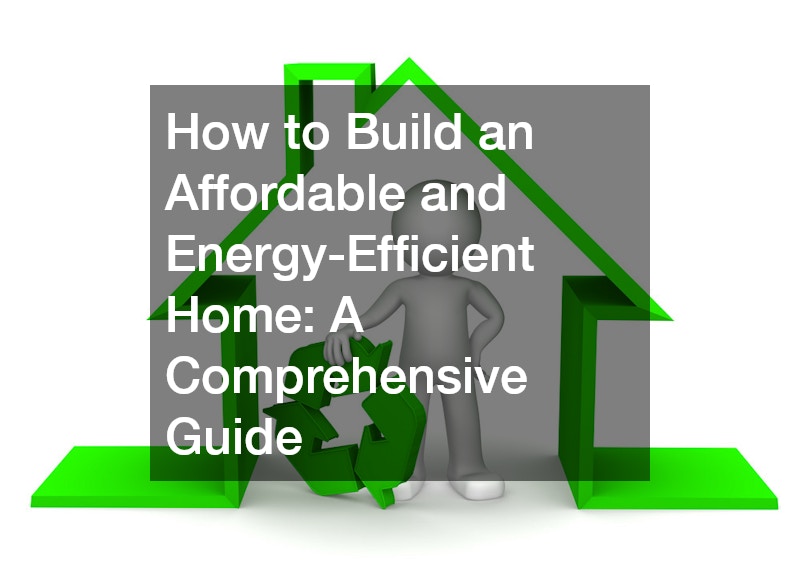The appeal of traditional homebuilding has waned as energy costs have risen by more than 20% worldwide in the last year. It is now clearer than ever why it is so important to learn how to build an energy-efficient home. Inefficient energy practices harm both the environment and household budgets. Sustainable living is no longer a trend but a necessity.
This guide is intended to help you build a home that is energy-efficient and budget-friendly. It is aimed at homeowners who want to reduce their carbon footprint without breaking the bank. Sustainable home design is not just about saving money on utilities but also about creating a healthier environment and preserving the planet.
Building an energy-efficient house offers many benefits beyond cost savings. These homes are typically more comfortable due to stable indoor temperatures, which result from energy-efficient materials and intelligent design choices such as passive solar design and well-planned HVAC systems. By building a home with these principles in mind, you can create a residence that is both future-proof and cost-effective as energy prices continue to rise.
Understand Energy Efficiency in Homes
Energy efficiency in homes is vital for reducing utility costs and minimising environmental impact. With advancements in technology, homeowners can modify or construct their homes to optimise energy usage. This section will explore key concepts and practical ways to enhance energy efficiency, focusing on why it is important and how it can be implemented through design and systems upgrades.
Why Is Energy Efficiency Important?
Energy efficiency ensures that every unit of energy is utilised effectively. Homeowners can reduce their utility costs and carbon footprint by optimising energy consumption. This concept goes beyond using energy-saving devices; it involves a holistic approach that includes improving the building’s systems and envelope to minimise energy waste.
A comprehensive approach to energy efficiency considers all aspects of the home, from window placement and insulation to the type of heating system. Integrating these elements into a cohesive system ensures sustainability and maximises benefits.
Building the Foundation: A Tight Building Envelope
The building envelope includes all physical barriers separating the interior from the exterior of your house—walls, roofs, foundations, windows, and doors. These components are crucial for maintaining energy efficiency by controlling heat transfer. When designed and insulated properly, they can help homes stay warm in winter and cool in summer, reducing the need for excessive heating or cooling.
Insulation and Air Sealing
High-Performance Insulation
- Choose insulation materials with high R-values, such as spray foam, rigid foam boards, or blown-in cellulose.
- Use thicker insulation in areas prone to heat loss, such as roofs and walls.
Air Sealing Strategies
- Use caulking and weatherstripping around windows and doors to prevent air leaks.
- Apply spray foam insulation to seal gaps and holes where pipes or wires enter the structure.
Thermal Bridges
- Address areas where materials like concrete or metal create a pathway for heat transfer. Use thermal breaks to minimise heat loss.
Energy-Efficient Windows and Doors
Windows and doors are critical for regulating your home’s climate and preventing energy waste.
Windows
- Choose double-glazed or triple-glazed windows with low-emissivity (Low-E) coatings to reflect heat.
- Ensure windows have a low U-factor and a solar heat gain coefficient (SHGC) appropriate for Australia’s climate zones.
Doors
- Opt for doors with high insulation values.
- Install weather seals to prevent air leakage and use draught excluders to enhance performance.
HVAC Systems: Heating, Ventilation, and Cooling
An efficient HVAC system is essential for maintaining a comfortable indoor environment while reducing energy usage.
High-Efficiency Systems
- Look for HVAC systems with high star ratings under Australia’s energy labelling scheme.
- Consider variable-speed units that adjust airflow based on demand, improving comfort and energy savings.
Heat Pumps
- Heat pumps combine heating and cooling in one system and are ideal for Australia’s moderate climates.
- Check the seasonal performance ratings to ensure compatibility with your energy goals.
Ductwork Design
- Ensure ducts are well-designed and insulated to minimise energy loss.
- Seal all ductwork to prevent leaks that can compromise system efficiency.
Efficient Hot Water Systems
Hot water systems are significant energy consumers in Australian homes. Choosing an efficient system can reduce both energy usage and costs.
Tankless Water Heaters
- These systems heat water on demand, eliminating the standby energy losses associated with storage tanks.
- Ensure your home’s water pressure is compatible with tankless systems for optimal performance.
Solar Water Heating
- Solar water heaters use rooftop panels to capture sunlight and heat water stored in an insulated tank.
- While the initial installation costs are higher, the long-term savings and environmental benefits make solar systems a worthwhile investment, particularly in Australia’s sunny regions.
Lighting Strategies for Energy Efficiency
Lighting choices can greatly impact a home’s energy efficiency. Selecting the right lighting solutions can reduce electricity consumption while creating a pleasant atmosphere.
LED Lighting
- LED bulbs use up to 80% less energy than traditional incandescent bulbs and last significantly longer.
- Choose LEDs with adjustable brightness to save energy and tailor lighting to your needs.
Daylight Harvesting
- Maximise natural light by strategically placing windows, skylights, and light shelves.
- Use reflective surfaces and lighter interior colours to enhance daylight penetration and reduce the need for artificial lighting.
Integrating Sustainable Living Practices
Adopting sustainable practices in your home is about more than just cost savings—it’s about contributing to a healthier planet.
Energy-Efficient Appliances
Invest in appliances with high star ratings under Australia’s energy labelling program. These appliances use less energy and water, helping you save on utilities while reducing environmental impact.
Smart Home Technology
Smart thermostats, lighting controls, and energy monitors can optimise your home’s energy usage. These devices adapt to your lifestyle and usage patterns, ensuring energy is used efficiently.
Water Conservation
- Install low-flow showerheads and taps to reduce water consumption.
- Use rainwater tanks to collect and reuse water for gardening or household cleaning.
Renewable Energy Sources
Consider installing rooftop solar panels, which are increasingly affordable in Australia due to government rebates and incentives. Even small installations can significantly reduce reliance on the grid and lower energy bills.
Passive Solar Design: Harnessing Nature’s Power
Passive solar design takes advantage of natural sunlight and airflow to heat, cool, and light your home effectively.
Site Orientation
- Position your home to maximise sunlight in winter while minimising exposure during summer.
- Use landscaping, such as trees and pergolas, to provide shade and improve energy efficiency.
Thermal Mass
- Incorporate materials like concrete, brick, or stone to absorb and store heat during the day and release it at night.
Ventilation
- Cross-ventilation designs enhance airflow and reduce the need for mechanical cooling.
Waste Management During Construction
Building a home generates waste, but sustainable practices can minimise its environmental impact.
Sustainable Skip Hire
- Choose a skip hire service that prioritises recycling and responsible waste disposal.
- Sort materials on-site to ensure items like wood, metal, and concrete are recycled effectively.
Eco-Friendly Materials
- Source locally produced, recycled, or sustainable building materials to reduce your home’s carbon footprint.
FAQs
What is the cost of building an energy-efficient home in Australia?
The cost can range from 5-20% more than a standard home, depending on features like solar panels, high-grade insulation, and advanced HVAC systems. However, these upfront costs are offset by long-term energy savings.
Can an energy-efficient home pay for itself over time?
Yes, the savings on energy bills, combined with government incentives, can make energy-efficient homes financially viable in the long term.
How can I make an existing home more energy-efficient?
Consider upgrades such as adding insulation, installing double-glazed windows, replacing outdated HVAC systems, and integrating renewable energy sources like solar panels.
What are the best materials for energy-efficient construction in Australia?
High-performance insulation, double-glazed windows, and sustainable timber or concrete are excellent choices.
Conclusion
Building a budget-friendly, energy-efficient home requires careful planning, thoughtful material selection, and the integration of advanced systems to reduce energy consumption and costs. These homes offer not only long-term savings but also increased comfort and a reduced environmental impact. By working with local contractors specialising in energy-efficient construction and leveraging Australian government incentives, you can create a home that is sustainable, cost-effective, and future-proof.


